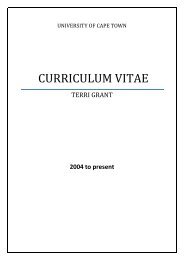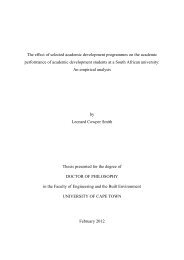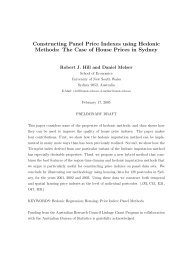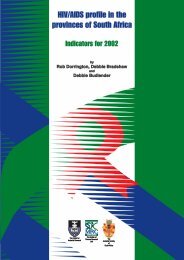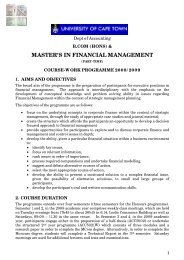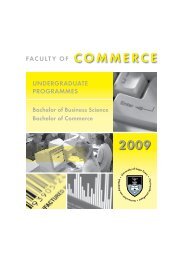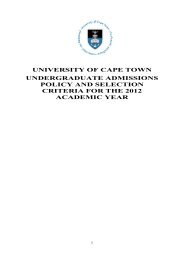Competition and Regulation in the Telecommunications Industry in ...
Competition and Regulation in the Telecommunications Industry in ...
Competition and Regulation in the Telecommunications Industry in ...
Create successful ePaper yourself
Turn your PDF publications into a flip-book with our unique Google optimized e-Paper software.
<strong>Competition</strong> <strong>and</strong> <strong>Regulation</strong> <strong>in</strong> <strong>Telecommunications</strong>• Under non-discrim<strong>in</strong>atory terms,• In a timely fashion under conditions that are transparent <strong>and</strong> fair, <strong>and</strong>• At rates determ<strong>in</strong>ed by ICASA. These will be set at <strong>the</strong> long run<strong>in</strong>cremental cost (LRIC) of build<strong>in</strong>g <strong>and</strong> ma<strong>in</strong>ta<strong>in</strong><strong>in</strong>g a network by anefficient telecommunications provider, <strong>in</strong>clud<strong>in</strong>g an average return oncapital. The <strong>in</strong>formation required for sett<strong>in</strong>g such rates, will be determ<strong>in</strong>edby <strong>the</strong> Chart of Accounts <strong>and</strong> Cost Allocation Manual (COA/CAM) that isobligatory for all network providers to submit.ICASA reserves <strong>the</strong> right to settle disputes over <strong>in</strong>terconnection <strong>and</strong> enforce<strong>the</strong> m<strong>in</strong>imum requirements established above for <strong>in</strong>terconnection agreements.Similar guidel<strong>in</strong>es have been established for facilities leas<strong>in</strong>g, ano<strong>the</strong>rimportant practice for fur<strong>the</strong>r<strong>in</strong>g competition <strong>in</strong> <strong>the</strong> telecommunications<strong>in</strong>dustry.The number<strong>in</strong>g plan has yet to be f<strong>in</strong>alised by ICASA though a proposedpolicy document has been released which provides us with an <strong>in</strong>sight <strong>in</strong>to <strong>the</strong>pr<strong>in</strong>ciples that ICASA is work<strong>in</strong>g with.For local access, <strong>the</strong> competition concerns revolve around number portability.Consumers face a cost of switch<strong>in</strong>g local access providers if <strong>the</strong>y have tochange <strong>the</strong>ir telephone number. This represents a barrier to entry <strong>and</strong> limitseffective competition from any new entrant. The switch<strong>in</strong>g costs <strong>in</strong>clude<strong>in</strong>form<strong>in</strong>g all associates of <strong>the</strong> change <strong>and</strong>, for bus<strong>in</strong>esses, adjust<strong>in</strong>g anyletterheads, bus<strong>in</strong>ess cards <strong>and</strong> <strong>in</strong>formational material that has <strong>the</strong> number onit. These costs are significant enough to prevent numerous changes occurr<strong>in</strong>g<strong>and</strong> so <strong>in</strong>itially provide <strong>the</strong> <strong>in</strong>cumbent with some market power. ICASA hasnot made a decision on this or provided any direction. The key problem is thatit does come with costs to <strong>the</strong> network provider because <strong>the</strong>ir networks needto be upgraded to operate number portability. ICASA is putt<strong>in</strong>g aside a blockof numbers <strong>in</strong> case number portability does not materialise <strong>and</strong> <strong>the</strong> newentrant requires its own numbers.For long-distance network providers <strong>the</strong> preferred outcome is that a customercan pre-select a long-distance network provider <strong>and</strong> so <strong>the</strong>re is no need todial additional digits first. Aga<strong>in</strong>, ICASA has not made policy on this butsuggests that pre-selection “may be a requirement under <strong>the</strong> new regulatorystructure” (SATRA 1999). An <strong>in</strong>terim measure is to use as short as possible‘carrier access code’ until pre-selection is available. The recognition is that <strong>the</strong>shorter <strong>the</strong> access code, <strong>the</strong> less <strong>in</strong>convenience to customers <strong>and</strong> so <strong>the</strong> lessdiscrim<strong>in</strong>ation aga<strong>in</strong>st <strong>the</strong> entrant. In order to allow consumers <strong>the</strong> flexibility toselect an alternative provider for <strong>in</strong>dividual calls, it is preferable to have preselectionoverride codes too. The issue of offer<strong>in</strong>g pre-selection concerns <strong>the</strong>upgrad<strong>in</strong>g of Telkom’s networks.For long-distance service providers who resale leased capacity, <strong>the</strong> accesscodes will be necessary. Ma<strong>in</strong>ta<strong>in</strong><strong>in</strong>g <strong>the</strong>se as short as possible is a means tomake <strong>the</strong>m more convenient to customers. If regulation allows serviceproviders to be pre-selected too, <strong>the</strong>n <strong>the</strong>se would not be necessary.34



